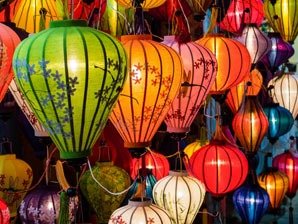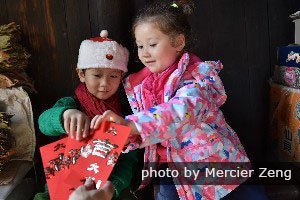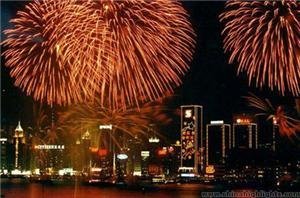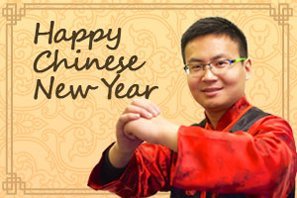
Laba Festival
Some Chinese start to celebrate and prepare for New Year as early as month 12 day 8 of the lunar calendar. This is a festival called Laba ( 腊八 Làbā /laa-baa/ '12th lunar month' + '8'). It's January 24 in 2018.
Cleaning the House
Clean housePeople clean their houses before Chinese New Year.
From the 23rd of the 12th lunar month (February 8, 2018), Chinese people carry out a thorough cleaning of their houses. The cleaning is called "sweeping the dust", and represents a wish to put away old things, bid farewell to the old year, and welcome the New Year.
New Year Shopping
People buy New Year food and snacks, New Year decorations, and clothes for New Year before New Year’s Eve. Chinese New Year, like Christmas in China, is a shopping boom time.
Chinese people may be thrifty most of the time, but they seem quite generous in their spending during their traditional festivals. For example, they buy everyone new clothes for the festival, whether they need them or not. There are New Year street markets on the days before the festival.
New Year's Eve Activities (February 15, 2018)
Putting Up Spring CoupletsPutting up spring couplets
Putting Up New Year Decorations
Although some people decorate their houses several days before the festival, most people do it on New Year's Eve. Houses are decorated with red lanterns, red couplets, New Year paintings, and red lanterns. 2018 is a year of the Dog, so dog images will appear on decorations.
Chinese New Year decorations are more complex in rural areas where people not only wish good luck for their family, but also for their livestock. Hence, people not only decorated their houses, but also the places where their livestock live.
People may decorate their houses using some or all of the following things...
Affixing Door God Images
Pasting a door god image on the door is an important custom among Chinese people during Spring Festival. In the beginning door gods were made of peach wood carved into the figure of a man, hanging by the door. Later people pasted printed images on doors.
People paste door gods on doors as a prayer for blessings, longevity, health, and peace. Two door gods on double doors are thought to keep evil spirits from entering. The door gods symbolize righteousness and power in China, therefore Chinese door gods are always scowling, holding various weapons, and ready to fight with evil spirits.
Putting Up Spring Couplets
Spring couplets or New Year couplets (春联: Chūnlián /chwn-lyen/) are paired phrases, typically of seven Chinese characters each, written on red paper in black ink, and pasted one each side of a door frame.
Sometimes a phrase of four or five characters is affixed to the top of the door frame as well. New Year couplets are filled with best wishes. Some people write the couplets themselves, but most people buy them (ready printed) from the market. Pasting spring couplets is thought to keep evil away.
Click to learn the Legend of Why Spring Couplets Are Pasted.
Putting Up New Year Paintings
paper cutoutsIt is a custom to paste paper cutouts on windows during the Chinese New Year.
New Year paintings carrying best wishes are put up to decorate houses, creating a happy and prosperous Spring Festival atmosphere.
The subjects of New Year paintings are often flowers and birds, plump boys and Guanyin (the Goddess of Mercy... and fertility), oxen, ripe fruit and treasure, or other legends and historical stories, showing desires for bountiful harvests and a happy life.
"The Four Homelands of the New Year Painting" are New-Year-Painting Village in Mianzhu, Sichuan Province; Taohuawu in Suzhou, Yangliuqing in Tianjin, and Weifang in Shandong.
Putting Up Paper Cutouts
In the past people pasted paper cutouts on windows facing south and north before the Spring Festival. Paper cutouts are still popular with northerners, but people in the south only paste paper cutouts on wedding days.
The subjects and themes of paper cutouts are rich. As the majority of buyers are peasants many are about rural life: farming, weaving, fishing, tending sheep, feeding pigs, raising chickens, etc. Paper cutouts sometimes depict myths, legends, and Chinese operas. Also flowers, birds, and Chinese Zodiac creatures are popular paper cutout designs.
Paper cutouts are usually diamond-shaped in lucky red, with beautiful and exaggerated patterns. They express hopes of a merry and prosperous life, in line with the Spring Festival theme.
Offering Sacrifices to Ancestors
offering sacrifices to ancestors in temple
Where: A popular custom since ancient times, ancestor worship varies widely across China — from sweeping tombs in the wild to worshiping ancestors in ancestral halls or temples. Many (especially rural southern Chinese) people offer sacrifices to their ancestors in the main hall of the house, where an ancestor altar is displayed.
How: Family members kneel and bow in front of the wall-mounted shrine or grave, from the oldest to the youngest. Offerings of meat, wine, joss sticks and joss paper are placed in front of the shrine/grave.
When: This custom is performed on several days of the Spring Festival, but most commonly on New Year’s Day. Many worship on New Year's Eve, before the reunion dinner to show that they are letting their ancestors "eat" first. Ancestor worship has been practiced in China every year for thousands of years.
Why: Offering sacrifices to ancestors shows respect, piety, and missing departed relatives on such a special festival. It is also believed that ancestral spirits will protect their descendants and make them become prosperous (if regularly worshiped with incense and offerings).
Enjoying a Reunion Dinner
Chinese New Year Eve dinner
The New Year's Eve Feast is a "must do" dinner with all family members reuniting. Chinese try very hard to make this family event, often traveling long distances. This is the main reason for the huge travel stress throughout China.
People from north and south China eat different foods on this special occasion, and many New Year foods are symbolic. In northern China a traditional dish for the feast is jiaozi (dumplings).
They are shaped like old Chinese ingots, symbolizing wealth. Southern Chinese eat niangao (sticky rice cake) on this special day, because niangao sounds like "yearly higher", symbolizing improvement.
Watching CCTV's New Year Gala
It's become a China custom for many familes to watch the CCTV New Year Gala while having their dinner. The Gala starts at 8pm and ends at midnight when the New Year arrives, featuring traditional, folk, and pop performances from China's best singers, dancers, and acrobats.

Giving Red Envelopes (Lucky Money) to Kids
chinese new year lucky money
Parents usually give their children red envelopes after the reunion dinner, wishing them health, growth, and good studies in the coming year. Red envelopes always have money in. Money in red envelopes is believed to bring good luck, as red is China's lucky color, so it's called lucky money.
Staying Up Late
This custom is called shousui (守岁 /show-sway/ ‘to keep watch over the year’). Chinese stayed up all night in the past, but now most stay up only till the midnight firecrackers and fireworks die down.
Listening to a New Year Bell
A bell is a traditional symbol of Chinese New Year, and Chinese believe that ringing a large bell can drive all bad luck away and bring good fortune. Chinese people like to go to large squares or temples where there are huge bells rung on New Year's Eve at midnight.
In recent years people have begun to go to mountain temples to wait for the first ringing of a bell in the new year. Hanshan Temple in Suzhou, in East China's Jiangsu Province, is famous for its bell to herald Chinese New Year. The custom is even beginning to be adopted by the expat community there.
Chinese New Year's Day (February 16, 2018)
Chinese people believe what they do on the first day of the lunar year affects their luck in that year.
Setting Off Firecrackers and Fireworks
Chinese New Year fireworks display
The moment New Year arrives there is a cacaphony of fireworks and firecrackers all around, even in rural China. Consider earplugs — it's like World War III! Fireworks sound like rocket lauchers, and chains of firecrackers make machine-gun-like noises. Families stay up for this joyful moment. See Why Chinese New Year Must Have Firecrackers?
The tradition is to set off one string of small firecrackers first, followed by three big firecrackers, which symbolize "sounding out" the old year and "sounding in" the new year. The louder the three firecrackers, the better and luckier it’s believed it will be for business and farming in the coming year.
In major cities: Lighting firecrackers is one of the most important customs of the Chinese New Year celebration, but because of the danger and the noise disturbance they cause, the government has banned this practice in many major cities, such as Beijing, Guangzhou, and Shanghai. Fireworks that explode in the air are still allowed in most of the country.
People in smaller cities, towns, and rural areas still practice the firecracker tradition, and it isn't generally considered dangerous. In many rural areas it's still the custom to set off firecrackers before dinner from New Year’s Eve to the CNY day 3.
Kids, with (mini) firecrackers in one hand and a lighter in another, cheerfully celebrate by throwing the small explosives one-by-one on the street whilst plugging their ears. Mini hand-held rocket launchers are also popular with children, which launch 10 or 20 small fireworks at 5 second intervals, looping across the streets.
Most people watch the public and private firework displays from midnight for about forty minutes.

Putting on New Clothes and Extending New Year Greetings
new year greeting
On the first day of the New Year, Chinese put on new clothes, and say "gongxi" (恭喜 /gong-sshee/ literally ‘respectful joy’, it means ‘greetings’ or ‘best wishes’), and wish each other good luck and happiness in the New Year. It is customary for the younger generation to visit their elders, and wish them health and longevity.
In recent years, a new way to do New Year greetings has appeared, especially among the young. Busy people who don't have time to visit their friends or relatives send a New Year card, a WeChat red envelope or a text message instead.
Watching Lion and Dragon Dances
Lion dances and dragon dances might be seen too on New Year's Day. Once very popular in China, they are reappearing in many places though. They are more popular in Hong Kong and Macau.
New Year: Day 2 (February 17, 2018)
Traditionally a married daughter visits the house of her parents on the second day of Chinese New Year.
New Year: Days 3–7 (February 18–22, 2018)
0Chinese visit relatives and friends from the 3rd day to the 7th day.
From the third day to the seventh day, Chinese visit relatives and friends.

On the third day, some Chinese go to visit the tombs of their clan or relatives, but some think being outside on the third day is inauspicious because evil spirits roam around.
The first house sweep of the new year: Chinese don't clean the house the first two days of the New Year, as sweeping then is believed to sweep away the good luck accrued by the mess of firecrackers, red paper, wrappers, and other evidence of the celebrations on the floor.
New Year: Day 8 (February 23, 2018)
People normally return to work by the eighth day. As eight is the luckiest number in China, most businesses prefer to reopen on New Year day 8.
New Year: Day 15 (March 2, 2018), the Lantern Festival
the Lantern Festivalthe Lantern Festival
The fifteenth day of the New Year is the Lantern Festival (元宵节 Yuánxiāo Jié /ywen-sshyaou jyeah/). It is the traditional end of the Spring Festival celebrations. People send aloft glowing lanterns into the sky while others let floating lanterns go on the sea, on rivers, or set them adrift in lakes.
thats a wonderful fireworks what a moment that was amazing
Hi! I am a robot. I just upvoted you! I found similar content that readers might be interested in:
https://www.chinahighlights.com/travelguide/festivals/chinese-new-year-celebration.htm
that is a great festival in china.
yes chines celebrate this with zeal
china is famous for celebration all over the world beautifuly written
thanks
china is very big country geographically,so their traditions ,costumes and festival are vary,but celebration are same
Amazing Pictures Bro